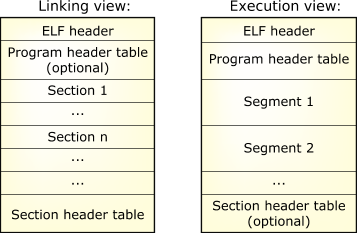To understand how a program makes use of shared objects, let's first see the format of an executable and then examine the steps that occur when the program starts.
- ELF format
- The QNX Neutrino RTOS uses the ELF (Executable and Linking Format) binary format.
ELF not only simplifies the task of making shared libraries, but
also enhances dynamic loading of modules at runtime.
In the following diagram, we show two views of an ELF file: the linking view and the execution view. The linking view, which is used when the program or library is linked, deals with sections within an object file. Sections contain the bulk of the object file information: data, instructions, relocation information, symbols, debugging information, etc. The execution view, which is used when the program runs, deals with segments.
At link time, the program or library is built by merging together sections with similar attributes into segments. Typically, all the executable and read-only data sections are combined into a single text segment, while the data and “BSS”s are combined into the data segment. These segments are called load segments, because they need to be loaded in memory at process creation. Other sections such as symbol information and debugging sections are merged into other, nonload segments.

Figure 1. Object file format: linking view and execution view. - ELF without COFF
- Most implementations of ELF loaders are derived from
COFF (Common Object File Format) loaders; they
use the linking view of the ELF objects at load time. This
is inefficient because the program loader must load the
executable using sections. A typical program could contain a
large number of sections, each of which would have to be
located in the program and loaded into memory separately.
QNX Neutrino, however, doesn't rely at all on the COFF technique of loading sections. When developing our ELF implementation, we worked directly from the ELF specification and kept efficiency paramount. The ELF loader uses the “execution view” of the program. By doing so, the loader's task is greatly simplified: all it has to do is copy to memory the load segments (usually two) of the program or library. As a result, process creation and library loading operations are much faster.